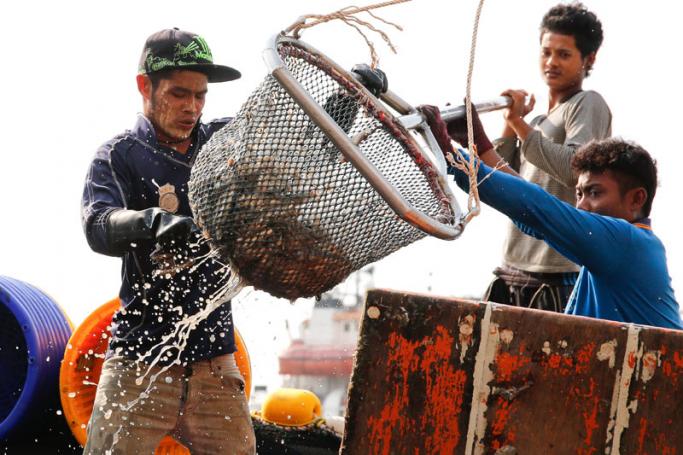Easing restrictions on labour migration can boost workers’ welfare and deepen regional economic integration, says a new World Bank report.
Intra-regional migration in ASEAN increased significantly between 1995 and 2015, turning Malaysia, Singapore, and Thailand into regional migration hubs with 6.5 million migrants – 96 percent of the total number of migrant workers in ASEAN, according to the report, entitled Migrating to Opportunity.
A substantial number of migrant workers are Myanmar nationals.
Approximately US$62 billion in remittances were sent to ASEAN countries in 2015. Remittances account for 10 percent of GDP in the Philippines, 7 percent in Vietnam, 5 percent in Myanmar, and 3 percent in Cambodia.
Low-skilled, and often undocumented, ASEAN migrants move in search of economic opportunity, mainly in the construction, plantation, and domestic services sectors. Higher-salary jobs are available, yet workers are not always able to take advantage of these opportunities. The ASEAN Economic Community has taken steps to facilitate mobility, but these regulations only cover certain skilled professions – doctors, dentists, nurses, engineers, architects, accountants, and tourism professionals – or just 5% of jobs in the region.
“With the right policy choices, sending countries can reap the economic benefits of out-migration while protecting their citizens who choose to migrate for work. In receiving countries, foreign workers can fill labor shortages and promote sustained economic growth, if migration policies are aligned with their economic needs. Inappropriate policies and ineffective institutions mean that the region is missing opportunities to gain fully from migration,” said Sudhir Shetty, World Bank Chief Economist for the East Asia and Pacific region.
Overall, migration procedures across ASEAN remain restrictive. Barriers such as costly and lengthy recruitment processes, restrictive quotas on the number of foreign workers allowed in a country, and rigid employment policies constrain workers’ employment options and impact their welfare. These restrictive policies are partly influenced by the perception that an influx of migrants would have negative impacts on receiving economies. However, there is evidence to the contrary. In Malaysia, simulations find that a 10 percent net increase in low-skilled immigrant workers increases real GDP by 1.1 percent. In Thailand, recent analysis finds that, without migrants in the labor force, GDP would fall by 0.75 percent.
“No matter where workers wish to migrate in ASEAN, they face mobility costs several times the annual average wage. Improvements in the migration process can ease these costs on prospective migrants, and help countries respond better to their labor market needs,” said World Bank Economist for the Social Protection and Jobs Global Practice Mauro Testaverde, the lead author of the report.
The impact of labor mobility on the region’s economies can be significant, as migration could provide individuals from lower-income countries with the opportunity to increase their incomes. The report estimates that reducing barriers to mobility would improve workers’ welfare – by 14 percent if only targeting high-skilled workers, and by 29 percent if including all workers.
A range of policies can be implemented to enhance workers’ mobility. More oversight of recruitment agencies is needed across the region. The highly-developed support system for migrant labor in the Philippines can serve as a model for other countries. Indonesia could improve coordination among relevant agencies and streamline procedures. Vietnam can benefit from a national migration strategy to guide reforms. Outmigration can be costly, particularly in lower-income countries such as Cambodia, Lao PDR, and Myanmar, where simplifying formal processes could help reduce costs.
Receiving countries can also introduce measures to maximize the benefits from labor mobility. Malaysia could adjust its migration policies to the country’s economic needs, including by revising its current levy system and by deepening coordination with sending countries. Thailand may benefit from formalizing undocumented migrants and making entry procedures less costly. While Singapore has developed a highly sophisticated and well-functioning migration system, attention should continue to be paid to the welfare of migrant workers.
You are viewing the old site.
Please update your bookmark to https://eng.mizzima.com.
Mizzima Weekly Magazine Issue...
14 December 2023
New UK Burma sanctions welcome...
13 December 2023
Spring Revolution Daily News f...
13 December 2023
Spring Revolution Daily News f...
12 December 2023
Spring Revolution Daily News f...
11 December 2023
Spring Revolution Daily News f...
08 December 2023
Spring Revolution Daily News f...
07 December 2023
Diaspora journalists increasin...
07 December 2023
Mizzima Media founder talks about staging a peaceful hijack












